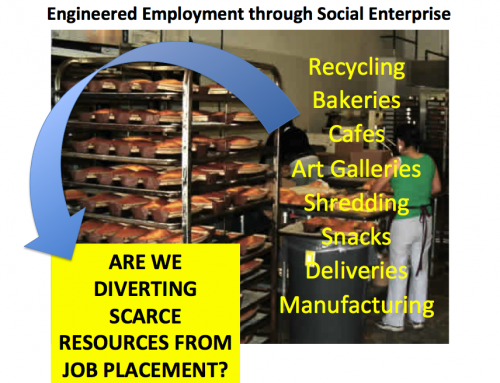Over the last year, I’ve been in front of numerous audiences to discuss the concept of Employment First and the need to phase out facility-based sheltered workshops. I don’t make the argument lightly. It is a wholesale change of focus for many. It uproots individuals from their comfort zone. It is threatening to agencies and parents. It requires funding and core policy shifts.
Yet, I have no doubt it is the right thing to do. And not just because it seems right from a value point of view, which it does. The reasons are multiple, and added up they are compelling.
1. Research has unequivocally found that those who attend workshops, when matched to those who don’t, earn less, have more limited vocational experience, and ultimately take longer to find jobs and cost more to serve over time.
2. Those who experience community employment and sheltered work choose community employment as their preference.
3. Segregation of people with disabilities has proven to make them more open to neglect, abuse, and exploitation.
 But regardless, I find that most of those who refuse to make changes to a sheltered work system simply aren’t listening. They don’t want to examine evidence, because they see no need to change what they are comfortable doing. The threat of change, and the likely corresponding difficulties that go with any change, are too troublesome.
But regardless, I find that most of those who refuse to make changes to a sheltered work system simply aren’t listening. They don’t want to examine evidence, because they see no need to change what they are comfortable doing. The threat of change, and the likely corresponding difficulties that go with any change, are too troublesome.But the burden of proof should always rest on those who have put people in environments that deviate from the typical experiences of our communities. We really shouldn’t have to prove community is better. Before placing someone in a workshop (or institution, group home, day habilitation, etc.) that program should first show evidence their outcomes exceed what can be experienced by people with disabilities in a community setting with reasonable-costing support. It’s like prescribing medication. Do the gains outweigh the side effects? Before you take any drug that will have an impact on your health, you would want to know what all its effects will likely be.
The default setting should always be what is typically experienced by community members as it applies to the life of a person with a disability, with reasonable support as needed.
All disability support, programs and interventions are actually accommodations, from a wheelchair to supported employment to sheltered work. The level of deviation from typical life varies in scale with each, as do their outcomes. When a disability program deviates from typical experience, there must be a cost-benefit analysis. That is, weigh the benefits of the intervention against the costs, including price, difficulty, risk of stereotyping and discrimination, and the risk of reducing quality of life and life experience.
For example, clearly a wheelchair has great benefits in increased mobility and corresponding independence. Compare this to its costs, which is not only its price, but also includes risk of discrimination and false stereotypes of lower intelligence, productivity, and more that people in wheelchairs have wrongly experienced. Despite the risks, most people with mobility needs use a wheelchair and confront the related issues.
But for workshops, the evidence clearly points to community employment as a better cost-benefit result. Maybe in the past, sheltered work showed a better outcome for individuals who would otherwise sit at home and do nothing; but that isn’t, nor should be, the situation today. Sheltered work is not today’s answer to disability unemployment. Disability facilities, the burden of proof lies with you. And there is no evidence there.






The information provided within “Ending Disability Segregation” by Dale DiLeo is irrefutable. There is no justification for the ongoing segregation of people with disabilities in the workplace or any other part of society. It is time that we all realize that this is a civil rights issue. It is just as wrong as slavery “employment” in the early 19th century and the ongoing Jim Crow practices that enforced societal segregation well into the middle of the 20th century in this country. That our nation, through the Centers for Medicare and Medicaid Services(CMS), continues to directly fund segregation is inexcusable. We must stand up and make it known that we will no longer tolerate this injustice that results in the social isolation and impoverishment of millions of U.S. citizens who receive this treatment only because they happen to experience disability. What are we waiting for???
sittpDale. Imagine if you are the one who is uprooted from your comfort zone. It appears that you cannot or will not accept the informed decisions made by people with disabilities who choose to remain employed in “sheltered workshops.” One size does not fit all.
sheltered workshops need to be closed down i worked for goodwill industries of central north at 1235 south eugene street in ngreensboro north carolina i was told i’d work there 30 days it was 34 days the vocational behabilitational counselor wanted me to work another 30 days take work adjustment classes i said i’m not intersted 2 weeks my counselor called me are you going back to goodwill i said on october 23rd 1986 asked me the same question would i reconsider going back i said no i only made$335.10 my slave wages
I am the mom of a young man who, after nearly 4 years, is graduating from pre-voc training and has a job in the community FINALLY! During this pre-voc, it has been mainly task-oriented work or occasional “paid work”, which was piece rate. He is enjoying being out in the community and I wish he would not have had to stay there for 4 years. The training needs to have measurable goals that are set for each individual and monitored on a regular basis, not just a yearly “he has done this/that/the other for the past X months”.